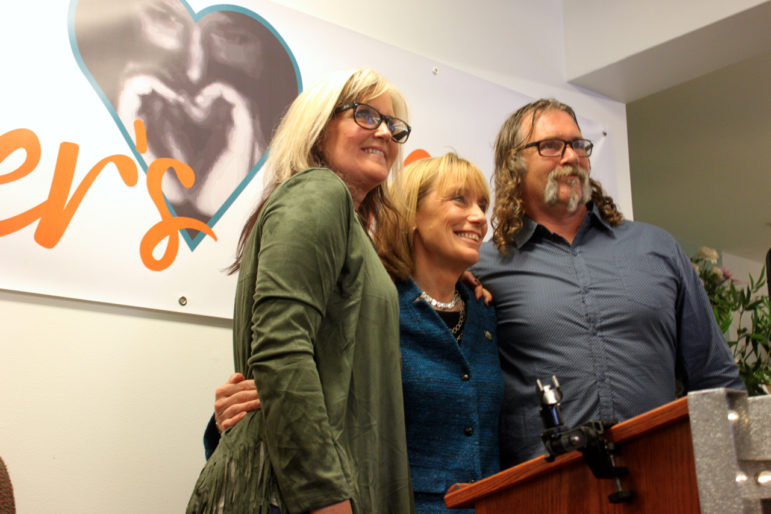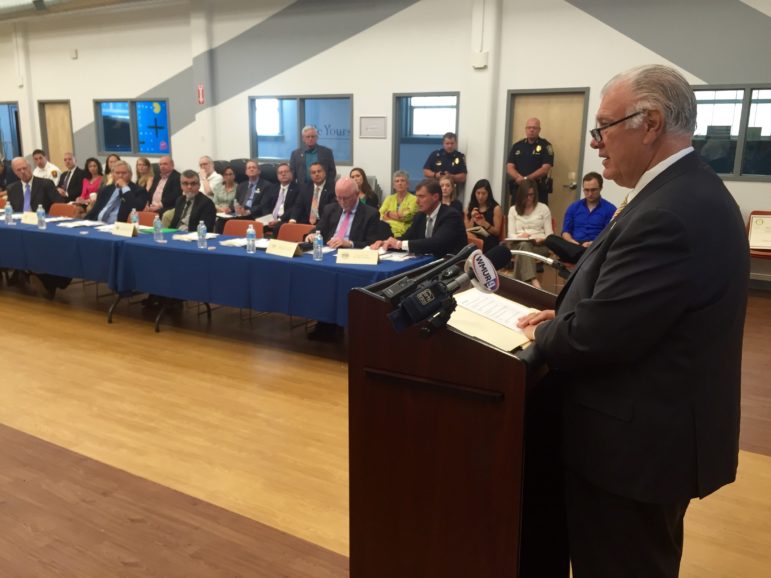
MANCHESTER, NH – After an ambitious launch and impressive outreach – helping to direct hundreds of “the sickest of the sick” to a pathway for recovery from addiction – a crisis shelter launched in April as Amber’s Place is weeks away from folding.
“Amber’s Place has been a special program,” says Holly Cekala, Vice President of Programs for HOPE for NH Recovery, which was the umbrella under which Amber’s Place opened and operated since April.
“More than 300 people have come through the doors, and about 72 percent of those have been placed in ancillary treatment and other supportive programs. It’s really helped so many people in a short amount of time, but nobody wants to fund it.”
She said last week that Amber’s Place, as it has operated, is “transitioning out” and the program, suspended, solely due to lack of funding.
“The only thing that will be different is that people won’t get that night or two of respite. It’s not that they won’t get what we’ve always done at HOPE. Amber’s Place was not part of the original design – it was useful, but never contractually arranged,” Cekala said. “That’s what people didn’t understand. So going forward, we’ll help with staff to make sure this place continues in some way, all in an effort to find a better sustainability model going forward.”

Named for Amber Blevens, who died in April of 2014 of a heroin overdose, the concept for the emergency shelter came from Kriss Blevens, Amber’s step-mom who, along with her husband, Mark, invested themselves in creating the kind of place they believed would have helped Amber find her way from homelessness to recovery.
Along the way Blevens personally worked as a board member for HOPE at raising money to support the program, which provided 16 cots and a safe place for those seeking recovery to wait for a place to continue their journey. Some find their way to residential treatment; others get connected to intensive outpatient services. Money raised for that effort is still in reserve under the fiduciary guidance of Granite United Way.
“We really don’t know what the fate of the program is at this point,” Cekala said. “We’re dealing with stakeholders and working hard with Serenity Place so that people can get access to clinical services they need. As for why Kriss resigned – I’m not privy to that.”
And that is where the story of Manchester’s push to increase recovery services for addicts gets complicated.
Blevens resigned Aug. 8 from the Board of Directors for HOPE for New Hampshire, citing concern for the lack of funding and resources. In doing so, she has also requested that the name Amber’s Place not be used for the emergency mission going forward.
“It was with powerful counsel that I resigned, and did a cease and desist using Amber’s Place name in conjunction with what they are doing. I ripped it out and am sacredly protecting it, to plant elsewhere,” said Blevens.
She said that the original vision of providing a safe harbor for those who were falling through the cracks was insufficient for the kind of clinical care addicts in crisis need.
“Crisis and community do not belong under one roof. A much higher level of informed care needs to be implemented for those coming into recovery,” Blevens said. “I’m talking about mental health and life skills as well as medical clearance and true professional clinical assessment.”
She said those coming into care may get into a 28-day program, but they still don’t know how to merge into society – that mission, which is the main thrust of HOPE for NH’s community recovery center model – was being compromised.
“I never intended Amber’s Place to be a burden to HOPE. I took a deep breath and dived in, knowing it was going to cost money to keep it going. I wanted it to sustain itself and be a blessing for HOPE for NH,” says Blevens. It was a difficult decision to resign, but I also knew it had to happen. I still believe Amber’s Place helped to shine a light on what’s really needed – a mission for those in crisis and quality transitional housing on the other side.”
The obstacles that remain – from the volatility of crisis care and lack of funding, to lack of housing – must be removed if real progress is to be made in this life-and-death battle.
And while Blevens is grateful that HOPE embraced her vision and, with Cekala’s help, made it a reality, she also feels strongly that a new model of care is needed – especially now that the Safe Station program is gaining momentum.

“Amber’s Place ignited a higher level of collaboration with other agencies, including Farnum Center, Phoenix House, Serenity Place – and it raised a lot of conversation around the population of those who are underinsured and uninsured,” Blevens said. “But there is no sustainability. As HOPE prepares to move forward to the Hoitt Building, it never intended to bring Amber’s Place with it. It just can’t carry the weight of what’s needed.”
As for HOPE’s much-anticipated move to the multi-level building on Wilson Street, Dick Anagnost said on Tuesday that the grand opening has been pushed back again, likely to December.
“It’s actually due to the fact that, with the recent award of tax credits, the project can now include Phase 3,” Anagnost said, which means retrofitting the third and fourth floors ahead of schedule to provide residential recovery for short- or long-term stays. The tax credit award was announced Tuesday, $615,000 from the New Hampshire Community Development Finance Authority.
Anagnost and Manchester business man Andy Crews of Autofair personally invested $300,000 in purchasing the Hoitt building. And the city of Manchester has invested $1.6 million from the city’s Community Improvement Program for the project. But the state has yet to chip in.
In the meantime, the need for services is on the rise.
All Hands On Deck
Manchester’s drug crisis has created an “all hands on deck” situation here. For the past two years the city has been struggling against the rising death toll attributed to heroin and fentanyl overdoses. While treatment options here are slowly emerging, New Hampshire is still considered just about the worst place to be, for anyone in need of help.
It’s a national crisis, and New Hampshire is at the epicenter of need.
The Centers for Disease Control recently analyzed multiple cause-of-death mortality data from the National Vital Statistics System to track current trends and shifting characteristics of drug overdose deaths across the country. Opioids— primarily prescription pain relievers and heroin — are the main driver of overdose deaths. Opioids were involved in 28,647 deaths in 2014 and opioid overdoses have quadrupled since 2000.

Of all the states, New Hampshire had the sharpest increase of overdose deaths – up 73.5 percent from 2013 to 2014.
NH Drug deaths by year (from the state coroner’s office):
2011 -201
2012 -163
2013 – 192
2014- 326
2015- 433
There have been bright spots in New Hampshire’s struggle to get a handle on this drug crisis. With no state or federal funding, HOPE for NH Recovery launched a community recovery center in July of 2015, a place that was supposed to be a soft landing with support and resources, for those who were on the road to recovery. Instead, the mostly volunteer staff quickly became overrun with the burden of helping people get past the crisis point.
And that is when Blevens stepped up with a vision to fill the urgent need for crisis intervention services. It was supposed to provide stabilization and bridge the gaps that exist between the rough edges of addiction and the various pathways to recovery.
But it has been more like learning to sail while the boat is moving, says Blevens. Due to the shifting tides and changes on the horizon, Blevens has temporarily removed herself from the mix.
Blevens’ vision of a safe place was guided by the spirit of her step-daughter, Amber, who she believes could have survived if such a place existed when she needed it most. But building a recovery infrastructure from the ground up on a shoestring budget isn’t adequate, says Blevens. She would like to carry Amber’s Place forward, perhaps as a new model, for recovery housing. Wheels are in motion for whatever comes next, and she remains on the board of Farnum Center. Her commitment to boosting recovery for addicts in New Hampshire is stronger than ever.
Safe Station and the need for resources
As of last week, Chris Hickey, the city’s Director of Emergency Services, says the phasing out of Amber’s Place has not really changed the process in place when someone comes into a fire station seeking help.
“Since we started May 4, we’re over 360 people so far – and that’s more than 300 unique first-time visits, that’s the number I concentrate on,” Hickey says. People will relapse and have to start over, and I have no problem with that. But the fact that we’ve had 300 people from all over New England – I’m talking Maine, Vermont, Massachusetts – it’s just astonishing.”
The current playbook is fluid, says Hickey, meaning that as new opportunities and partnerships arise, the way Safe Station operates will adjust itself.
“It will only improve. What started as an idea has become something I never saw coming,” Hickey said.

“And that speaks to the gravity of the situation. Manchester has always had its issues. But only 49 percent of those who’ve come through Safe Station have been from Manchester. In fact, I was just talking to a girl who came through Safe Station, who said she called around to a bunch of programs, was told there were waiting lists everywhere, and then some recovery center that I’d never heard of told her to go to a Manchester fire house. Word is spreading, that we’ve got a program and it works.”
Of course, another problem in the puzzle is the expectation that walking into a Safe Station will immediately result in a recovery bed, says Cekala.
Even though HOPE for NH closes its doors at 5 p.m., their team of recovery coaches are still on-call around the clock, and they go to wherever they are needed. One of the biggest problems is that people equate treatment to a bed. That’s the mentality of the moms and grandmoms, who want to drop off their loved one and then bring them back home in 28 days, fixed, Cekala said.
“When you have a public that is in so much need that a place like Amber’s Place became a ‘stop and drop’ model, people cling to that. That’s where there’s confusion. If you want help, it’s out there,” Cekala said. “It may not be a bed, but if you want treatment, we will help you find it.”
Alderman Pat Long says there won’t be a hiccup in transitioning from the respite model of Amber’s Place to something else. The problem is solved,” says Long.
In partnership with other existing programs, like Helping Hands, the main difference will be the lack of programming for those waiting for a recovery plan.
“We need to take a look at having an emergency plan, something I’m hoping to bring back up at the next Aldermanic special meeting on drugs and alcohol. We have a solid regional focus through our city health department, which oversees one of seven districts. But I believe we need a specific focus here in Manchester – we need to take inventory of what’s available, what people are doing, both non-profits and private entities, to create some synergies.”
Time is money, and the high cost of staffing and meals is a huge piece of the sustainability puzzle.
Urgent Need for Recovery Housing
In addition to the need for recovery housing in general, Long points out that the newly-approved Substance Abuse Treatment Community for Offenders (SATCO) program is set to launch for county jail inmates in September. That means by December, the first wave of participants will be released from jail, with ankle bracelets and a challenge to check in daily as they continue their recovery plan outside of jail.
“Where are they going to live, or work? What programs will they be in? If I’m in the program and I’m from Weare, and I get released with an ankle bracelet and am made to report in every day, I’m not going back to Weare; I have to be in Manchester every day, so I’m looking for a place in Manchester,” Long said.
The good news is that in two years, several vital puzzle pieces are in place, says Long. There is a plan for those seeking relief, through Safe Station, to get individuals moving away from addiction, and reducing the demand side of this drug scourge.
“The difficulty is dollars. It’s foolish we have to worry about money, and I’m saying that publicly. We’re putting a price on people’s lives. We have a plan that’s working, that’s saving lives. If we could fund it all fully, we know it will continue saving lives. But we fall short because we don’t have enough financing.”
The bottom line for Long is being prepared to meet the need.
“If you want help, there’s help available, and that’s a good thing. I’d like to see 500 people in a week show up for help through Safe Station, because I believe that’s the need,” says Long.
“When I first started talking about drug court and the potential need, we figured conservatively that there were 2,000 people in Manchester with substance use disorder, whether alcohol, drugs, or what have you. Based on what we know, the need is probably bigger than that, so once we go back to the supply and demand model, knocking down demand will take more resources. At some point, as the program continues to succeed, my concern is we’re not going to be prepared on the other side,” Long said. “Somehow, some way, we have to keep this going. Once you get people showing up and there’s not someone to take their hand, that brings us back to where we started.”
Long would like to see the state revisit the state’s Alcohol Fund, which continues to be underfunded year after year by state lawmakers. Money allocated by state law from profits on state alcohol sales is supposed to go toward addiction treatment and recovery. Instead, it is going back into the general fund to balance the budget.

There’s a renewed push by non-profit advocacy group New Futures to fully restore the state’s Alcohol Fund. They outline three goals:
- To fully fund the Alcohol Fund at the original, legally mandated formula of 5 percent of gross alcohol sale profits.
- To ensure funds are not re-directed to the general fund.
- And to support critical services funded through the Alcohol Fund.
Although the 2016/2017 state budget maintained the integrity of the Alcohol Fund, the amended formula allocated only 1.7 percent of gross profits, instead of the intended mandated 5 percent. The total amount appropriated to the Alcohol Fund for the biennium was $6.6 million, instead of the $19 million available, had the fund been fully funded.
That money would go a long way to expediting treatment and services, says Long.
“One of the problems is that we’re supposed to have a 15 percent buffer in our rainy day fund, and we aren’t there, so we need to build that up. I get that. But as a state rep, I get disgusted when I talk about state issues – people are dying and we’re building up our rainy day fund.”
As state and local agencies regroup to fill the void that will be left by the absence of Amber’s Place, they say they are confident that the transition will create a stronger more comprehensive and sustainable program.
Blevens supports that mission, because the body count continues to rise and New Hampshire, for all it’s trying to do, still is falling short of meeting the critical need.
“I can’t avoid what I’ve been called to do. One death – Amber’s death – was enough for me to know it was time for action. I stepped up and tried to create something needed where there was nothing. It was a success. Lives were saved,” Blevens said.
“People are looking for an open door, to get from addiction to recovery. We’ve put out the invitation to get well. Now we have to make sure the help is there,” says Blevens. “Money needs to be transferred into a more sustainable model, for all aspects of recovery. The demand is so great, and we in the recovery community have to sort that out.”







